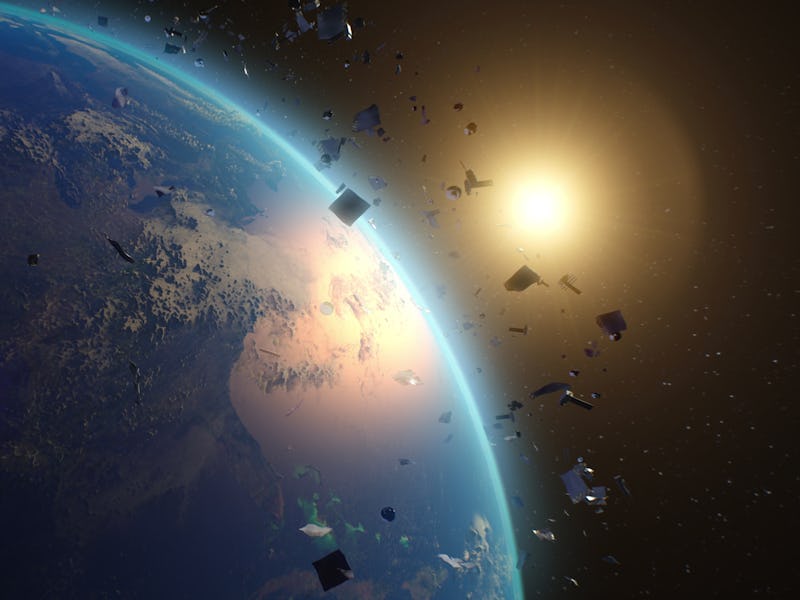What space junk and a Chinese satellite mean for the future of space
A Chinese weather satellite was struck by space debris in March, and the US Space Force recently confirmed decades old Russian space junk is to blame.

Russia is back in space debris hot water after the US Space Force determined debris from a Russian satellite launched years ago may have struck and damaged a Chinese weather Satellite in March 2021.
The update comes on the heels of a Russian military anti-satellite missile (ASAT) test in November, which destroyed a defunct Soviet spy satellite and generated more than 1,500 pieces of space debris. Astronauts and Russian cosmonauts aboard the International Space Station took emergency shelter in the days following the ASAT test, which led to international condemnation of the test.
While the March collision with the Chinese weather satellite was accidental, and the debris at fault stemmed from a launch in the 1990s, it illustrates the potentially growing danger from space debris. A certain number of unintentional collisions become inevitable as the number of objects in orbit swells, with each event generating additional navigation hazards.
Given that SpaceX alone plans to add tens of thousands of satellites in the coming years, space debris mitigation is something humans need to get a handle on or risk losing access to space entirely.
What happened?— China’s Yunhai 1-02 meteorological spacecraft was struck by “a small, mission-related debris” associated with the launch vehicle for that lofted Russian satellite Cosmos 2333 to orbit in 1996. That’s according to NASA’s Orbital Debris Quarterly publication released in December.
The collision generated 37 new pieces of space debris, although four of those pieces of space junk had re-entered the Earth’s atmosphere by early October.
NASA’s newsletter notes the March collision marks the fifth such accidental between tracked objects in orbit:
- The first such confirmed accident was a collision between a Russian Cosmos satellite and a piece of launch-related debris in 1991
- The second confirmed accidental collision involved a French spy satellite and debris from a French rocket in 1996
- The third confirmed accidental collision occurred in 2005 when fragments from a Chinese rocket that exploded in 2000 struck a US military weather rocket
- The fourth confirmed accidental on-orbit collision occurred in 2009 when a US Iridium communications satellite struck a Russian Cosmos satellite
NASA video simulating space junk in orbit around Earth.
Why it matters — As far as on-orbit collisions go, the one that happened in March was fairly benign. It generated relatively few pieces of additional debris rather than thousands, no one got hurt or threatened, and according to reporting by SpaceNews, Yunhai 1-02 is still somewhat operational.
But as a symptom of things to come, the Yunhai 1-02 collision is worrying.
There are roughly 40,000 objects at least 10-centimeters across being tracked in orbit, and only 5,000 of them are active satellites. There are potentially millions of pieces of debris a centimeter square or smaller, but they’re very difficult or impossible to track.
A piece of space debris as seen from the ISS in 2004.
Every time a satellite or space station operator has to move their asset out of the way of a piece of space junk, it uses up fuel, reducing the lifespan of that asset. And if they choose to hold tight when a potential collision rears its head, they could lose their satellite entirely or lose some of its functionality.
So even when there are no collisions, space junk makes space more expensive. And collisions are inevitable. Harvard Astrophysicist Jonathan McDowell recently told Inverse that the collision rate increases as the square of the number of satellites in orbit. Add 10 times as many satellites, which SpaceX, OneWeb, and other satellite mega constellation operators plan to do in the coming years, and you get 100 times as many collisions.
And more collisions that generate more debris then increase the chance of further collisions and more debris, a slow-moving but potentially inexorable chain reaction known as the Kessler Syndrome. Taken to the extreme, it could generate so much debris that no one can safely access space at all anymore.
What’s next?— In the short term, presumably, China will pursue restitution from Russia for the damage to Yunhai 1-02.
Under the Outer Space Treaty of 1967, objects in space remain the property and responsibility of nations that launch them, even decades after they have ceased to function, so Russia is obligated to make things right with China. The former-Soviet Union paid Canada $3 million as compensation for the 1977 crash of a Cosmos spy satellite that scattered radioactive material across northern Canada.
In the long term, it’s possible the pile-on of space debris events — from Russia’s ASAT test, recent collision avoidance maneuvers by the ISS, and the latest about Yunhair 1-02 — will convince spacefaring nations that it’s time to work out new agreements and best practices for keeping space clear of debris.